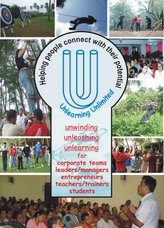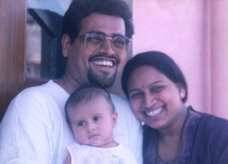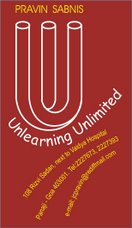Yesterday, 45 workers at the Kaiga nuclear plant in Karwar, Karnataka suffered from radiation from contaminated water. While the Atomic Energy Commission may allege an act of sabotage, the worst fears are coming true for all who were opposed to the setting up of the plant. Sadly, we refuse to learn the lessons from man-made disasters.
Twenty-five years ago, at midnight on 3 December 1984, it was a tryst with fatality for over 500,000 people in Bhopal. The Union Carbide plant released methyl isocyanate gas and other chemicals, killing nearly 10,000 in 72 hours and thrice the number have since died from gas-afflicted diseases. Even now, 390 tonnes of toxic chemicals abandoned at the plant continue to contaminate the ground water in Bhopal and affect its residents.
Here in Goa, hazardous wastes from polluting industries is released into surface as well as ground waters. Man made disasters are a creation of callous corporates for whom profits are a greater priority than the lives of human beings. Our natural resources and human resource are under attack by the pied pipers of economic prosperity. The appreciation of wealth of a few is resulting in the depreciation of the health of many.
It is only at our peril that we can ignore the menace, of ‘toxification’ of our ecosystem. Any act that worsens the condition of land and lives cannot be accepted as development. But plain indignation by the citizens can never suffice. It would be better to commit ourselves to real actions to ensure that there are no more Bhopals! We must treat all man made disasters as acts of bio-terrorism and counter them, their promoters and apologists as such.
To BE BETTER at learning the Bhopal lesson,
We must treat man made disasters as treason!
- Pravin K. Sabnis
Monday, November 30, 2009
Monday, November 23, 2009
PAST TENSE?
"You'd turn out this way too, if you had a childhood like mine" was the answer two brothers gave whenever asked why their lives turned out the way they did. They shared a dreadful childhood. Their mother died young and their father was an abusive alcoholic who was violent with his children. Their nurturing was in the midst of the worst of family conditions. Obviously, all this had a huge impact on their eventual life scripts.
One brother could not cope with school and dropped out. He involved in various businesses and went through many lows. Like his father, he took to excessive drinking. After marriage, he would shout at and beat up his wife and his children, just like his father did. An unfortunate story was being repeated all over again.
His other brother too dropped out from school. He joined the trade of a mechanic and began to earn a decent living. He enrolled at a night school and went on to educate himself. He was a sensitive and supportive husband to his wife and a caring and doting father to his children.
Both brothers could not change their terrible past. Yet their diverse life scripts are a pointer that our life is eventually about the choice we make. While one brother succumbed to the dead weight of his past, the other chose to learn from his past and ensure that it was not repeated.
Pedro says, “the past tells where you come from, but it does not tell where you will go”. Where we go is decided not by our past but our response to it. Life is the script that we write by our actions and attitude. If we want our life to be better, we must go beyond the burdens of the past.
Whether our past was tense or whether it was the best…
Our life must go beyond to BE BETTER by laying it to rest!
- Pravin K. Sabnis
One brother could not cope with school and dropped out. He involved in various businesses and went through many lows. Like his father, he took to excessive drinking. After marriage, he would shout at and beat up his wife and his children, just like his father did. An unfortunate story was being repeated all over again.
His other brother too dropped out from school. He joined the trade of a mechanic and began to earn a decent living. He enrolled at a night school and went on to educate himself. He was a sensitive and supportive husband to his wife and a caring and doting father to his children.
Both brothers could not change their terrible past. Yet their diverse life scripts are a pointer that our life is eventually about the choice we make. While one brother succumbed to the dead weight of his past, the other chose to learn from his past and ensure that it was not repeated.
Pedro says, “the past tells where you come from, but it does not tell where you will go”. Where we go is decided not by our past but our response to it. Life is the script that we write by our actions and attitude. If we want our life to be better, we must go beyond the burdens of the past.
Whether our past was tense or whether it was the best…
Our life must go beyond to BE BETTER by laying it to rest!
- Pravin K. Sabnis
Monday, November 16, 2009
DOOMSDAY RETURNS
“I worry that, especially as the Millennium edges nearer, pseudo-science and superstition will seem year by year more tempting, the siren song of unreason more sonorous and attractive.” – Dr Carl Sagan
Dr Sagan’s apprehensions about modern gullibility continue to resonate in the present millennium as well. A latest disaster film makes specious claims interlaced with purportedly scientific message to suggest that the world would end in 2012. A fictitious website (set up by the producers of the film) lists the Nibiru collision, a galactic alignment and increased solar activity among its possible doomsday scenarios.
David Morrison of NASA received over 1000 inquiries from people who thought the website was genuine. He has condemned it, saying "I've even had cases of teenagers writing to me saying they are contemplating suicide because they don't want to see the world end. I think when you lie on the Internet and scare children in order to make a buck that is ethically wrong."
It is necessary to put the current hype about Mayan calendars and doomsday predictions in context. Though most prophecies of doom come from a religious perspective, the secular crowd has caused its share of scares as well. But it is pertinent to note that the one thing the doomsday scenarios tend to share in common is that ‘they don't come to pass!’
Yet the gullible continue to accept the incredulous. And yet, we do not pay heed to real imminent problems like global warming, pollution pressure, growing economic disparity and skewed developmental policies. It would be better if we trash doomsday predictions and instead set right our own irresponsible actions that may spell doomsday for the future generations.
In our real world there is much to be done; there is much to fear…
It will BE BETTER if we let go of the worry of a fake-doomsday year!
- Pravin K. Sabnis
Dr Sagan’s apprehensions about modern gullibility continue to resonate in the present millennium as well. A latest disaster film makes specious claims interlaced with purportedly scientific message to suggest that the world would end in 2012. A fictitious website (set up by the producers of the film) lists the Nibiru collision, a galactic alignment and increased solar activity among its possible doomsday scenarios.
David Morrison of NASA received over 1000 inquiries from people who thought the website was genuine. He has condemned it, saying "I've even had cases of teenagers writing to me saying they are contemplating suicide because they don't want to see the world end. I think when you lie on the Internet and scare children in order to make a buck that is ethically wrong."
It is necessary to put the current hype about Mayan calendars and doomsday predictions in context. Though most prophecies of doom come from a religious perspective, the secular crowd has caused its share of scares as well. But it is pertinent to note that the one thing the doomsday scenarios tend to share in common is that ‘they don't come to pass!’
Yet the gullible continue to accept the incredulous. And yet, we do not pay heed to real imminent problems like global warming, pollution pressure, growing economic disparity and skewed developmental policies. It would be better if we trash doomsday predictions and instead set right our own irresponsible actions that may spell doomsday for the future generations.
In our real world there is much to be done; there is much to fear…
It will BE BETTER if we let go of the worry of a fake-doomsday year!
- Pravin K. Sabnis
Monday, November 9, 2009
SINGLE STORY
“The single story creates stereotypes. And the problem with stereotypes is not that they are untrue, but that they are incomplete.” - Chimamanda Ngozi Adichie
In the early 80’s, a single story was spread about the Sikh community in India … that all of them were violent terrorists deserving to be shot down by the Army. This single story sought to condemn an entire community which actually carries many dimensions of humanism, humour, entrepreneurship and infectious enthusiasm. Today, though that vicious single story of the Sikhs is no longer a part of our consciousness… the actions and attitudes born of it have left behind a bloody trail of brutality and killing.
Single stories give rise to stereotypes and prejudices that lead us to opinions ranging from contempt to hatred, from false pride to a negative sense of history, from insensitivity to irrationality. Stories cannot be just painted in black and white with shades of grey. They must reflect the entire assortment of facts, contradictions and possibilities. The hue has to reflect the human diversity in its multiple dimensions and its many stories.
Nigerian writer, Chimamanda Ngozi Adichie, makes the pertinent point that the single, stereotyped story flattens the experience to a singular and dangerously-damaging dimension. She insists that multiple stories matter, “Stories have been used to dispossess and to malign. But stories can also be used to empower, and to humanize. Stories can break the dignity of a people. But stories can also repair that broken dignity.” And it is such multiple stories that can save us from the danger of a single story! (http://www.ted.com/talks/chimamanda_adichie_the_danger_of_a_single_story.html)
To BE BETTER at breaking the stereotype …
We must go beyond the single story hype!
- Pravin K. Sabnis
In the early 80’s, a single story was spread about the Sikh community in India … that all of them were violent terrorists deserving to be shot down by the Army. This single story sought to condemn an entire community which actually carries many dimensions of humanism, humour, entrepreneurship and infectious enthusiasm. Today, though that vicious single story of the Sikhs is no longer a part of our consciousness… the actions and attitudes born of it have left behind a bloody trail of brutality and killing.
Single stories give rise to stereotypes and prejudices that lead us to opinions ranging from contempt to hatred, from false pride to a negative sense of history, from insensitivity to irrationality. Stories cannot be just painted in black and white with shades of grey. They must reflect the entire assortment of facts, contradictions and possibilities. The hue has to reflect the human diversity in its multiple dimensions and its many stories.
Nigerian writer, Chimamanda Ngozi Adichie, makes the pertinent point that the single, stereotyped story flattens the experience to a singular and dangerously-damaging dimension. She insists that multiple stories matter, “Stories have been used to dispossess and to malign. But stories can also be used to empower, and to humanize. Stories can break the dignity of a people. But stories can also repair that broken dignity.” And it is such multiple stories that can save us from the danger of a single story! (http://www.ted.com/talks/chimamanda_adichie_the_danger_of_a_single_story.html)
To BE BETTER at breaking the stereotype …
We must go beyond the single story hype!
- Pravin K. Sabnis
Subscribe to:
Comments (Atom)



